The imperative for swift and efficient data transfer has become increasingly pronounced in the contemporary landscape of rapid technological advancements and an ever-accelerating digital environment. USB Type-C cables, a groundbreaking innovation in connectivity, have played a transformative role in redefining the data transfer landscape. These cables represent a paradigm shift by furnishing high-speed connections that cater to the diverse needs of various electronic devices. This blog explores the intricacies of maximizing the potential of USB Type-C cables, elucidating a spectrum of strategies and best practices. By doing so, it aims to empower users with the knowledge necessary to facilitate expeditious and seamless data transfer experiences. By exploring these techniques, users can harness the full capabilities of Type-C cables, ensuring a level of efficiency that aligns with the demands of our dynamically evolving digital era.
Opt for Premium-Quality Type-C Cables
To kickstart the journey towards accelerated data transfer, prioritize the selection of top-tier Type-C cables. Investing in high-quality cables is the foundational step in guaranteeing swift and reliable data transmission. Direct your attention towards cables that bear certifications from esteemed manufacturers and adhere to the rigorous standards of USB 3.1 or USB 3.2. These standards are not arbitrary; they signify that the cables have been meticulously engineered to deliver optimal data transfer rates, ensuring a seamless and high-performance user experience. By choosing such cables, you are laying the groundwork for a robust and efficient data transfer infrastructure.
Verify Seamless Device Compatibility
Prioritize a hassle-free data transfer experience by meticulously confirming the compatibility of both the source and destination devices with USB Type-C connectivity. It is imperative that these devices not only support USB Type-C but also align with the same USB generation standards, be it USB 3.1 or USB 3.2. This synchronization is crucial as the slowest device inherently constrains the data transfer speed within the connection. By ensuring uniform USB compatibility across devices, you mitigate the risk of bottlenecks and pave the way for optimal data transfer rates, creating a harmonious and efficient connection between your devices.
Confirm USB-C Ports and Employ Hubs
Before embarking on data transfers, meticulously confirm that your devices are equipped with USB-C ports explicitly designed for high-speed data transfer. When appropriately rated, these ports serve as the conduits for swift and efficient data exchange. Furthermore, when connecting multiple devices, consider the integration of a USB-C hub possessing the correct specifications. This strategic use of a hub ensures the maintenance of fast data transfer speeds across various connected devices. By verifying both individual ports and incorporating hubs judiciously, you establish a comprehensive and optimized infrastructure for seamless data transfer within your digital ecosystem.
USB 3.1 and 3.2 Compatibility
Elevate your data transfer capabilities by ensuring compatibility with USB 3.1 or 3.2 for both your cables and devices. Adopting these advanced USB generations is paramount for unlocking significantly higher data transfer speeds when juxtaposed with their predecessors. By aligning your hardware with USB 3.1 or 3.2 standards, you not only future-proof your setup but also capitalize on the enhanced efficiency and rapid data exchange facilitated by these cutting-edge technologies. This strategic alignment underscores a commitment to harnessing the full potential of modern connectivity standards, resulting in a notable leap forward in data transfer performance.
Keep Cables Free from Damage
Safeguard optimal data transfer speeds by routinely inspecting your Type-C cables for any indications of wear and tear. The integrity of these cables is pivotal, and any compromise can markedly diminish data transfer efficiency. During regular examinations, check for signs such as fraying, exposed wires, or bent connectors. If you observe any of these telltale signs of damage, it is imperative to promptly replace the cable. This proactive approach ensures the longevity of your cables and guarantees sustained optimal performance, reinforcing the reliability of your data transfer infrastructure.
Data Cable, Not Just a Charging Cable
Exercise discernment in your cable selection by opting for those explicitly engineered for data transfer rather than exclusively designed for charging purposes. Despite the versatility of many Type-C cables that can handle both functions, prioritizing cables specifically crafted for data transfer yields superior performance. These purpose-built data cables are optimized to meet the demands of high-speed data exchange, ensuring efficiency and reliability in your transfer processes. By making this conscious choice, you elevate the performance of your data transfer endeavors, underscoring the importance of tailored solutions in the ever-evolving connectivity landscape.
Opt for Minimal Cable Length
Enhance data transfer speeds by embracing shorter cable lengths. The correlation between cable length and data transfer speed is pivotal, with shorter cables typically delivering faster performance. Strive to use the briefest cable that fulfills your requirements, as this practice minimizes signal loss and interference. By prioritizing minimal cable length, you effectively mitigate the potential drawbacks of extended cables, fostering an environment conducive to optimal data transfer rates. This strategic approach reflects a commitment to efficiency and precision in managing your connectivity infrastructure.
Strategize Large File Transfers for Off-Peak Hours
When transferring substantial data files and possessing control over your network, deliberate on scheduling these operations during off-peak hours. This strategic timing is a proactive measure to avert network congestion, consequently facilitating faster data transfer rates. By capitalizing on periods when network usage is minimal, you optimize the available bandwidth, diminishing the likelihood of data transfer bottlenecks. This thoughtful approach underscores a commitment to efficiency, ensuring that large file transfers occur seamlessly and expeditiously within the broader context of network management.
Optimize Bandwidth by Closing Background Applications
Streamline your data transfer process by closing extra applications running in the background on your computer or device. These background processes can significantly affect bandwidth, potentially impeding data transfer speeds. To ensure an uninterrupted and accelerated transfer experience, prioritize closing unnecessary applications and freeing up bandwidth resources for the primary task. This conscientious management of background processes contributes to efficiently utilizing available bandwidth, aligning with maintaining swift and seamless data transfer speeds.
Deploy Trusted Data Transfer Software
Facilitate seamless file transfers between devices by leveraging dependable data transfer software. When contemplating the movement of files, the utilization of reliable software becomes paramount. Specialized data transfer applications optimize the transfer process and ensure the judicious use of available bandwidth. This strategic approach goes beyond conventional methods, offering enhanced control and efficiency in managing data transfers. By choosing reputable software solutions, you empower yourself with tools designed to streamline the transfer process, ultimately contributing to an efficient and effective utilization of available network resources.
Integrate Error Checking and Correction Mechanisms
Elevate the reliability of your data transfer endeavors by incorporating error-checking and correction features. Certain devices and specialized data transfer software offer support for these mechanisms. Activating this functionality becomes instrumental in preserving data integrity throughout the transfer process. By proactively identifying and rectifying errors, the need for time-consuming retransmissions is mitigated, preventing potential slowdowns. This strategic employment of error checking and correction underscores a commitment to data accuracy, enhancing the overall efficiency and fluidity of the transfer process.
Conclusion
Implementing the outlined strategies and best practices ensures the swiftness and reliability of your data transfer tasks. TAAR emerges as a beacon of excellence in data cables and chargers in this context. Renowned for their commitment to quality and adherence to USB 3.1 and 3.2 standards, TAAR's Type-C cables are engineered for optimal data transfer rates. Choosing TAAR means choosing a brand that aligns seamlessly with the best practices highlighted in this guide, ensuring that your data transfer endeavors are not only rapid but also secure and efficient. Whether safeguarding crucial files, sharing media, or synchronizing devices, TAAR's Type-C cables emerge as indispensable tools, saving you valuable time and amplifying your productivity in today's dynamic digital landscape.





Leave a comment
This site is protected by hCaptcha and the hCaptcha Privacy Policy and Terms of Service apply.